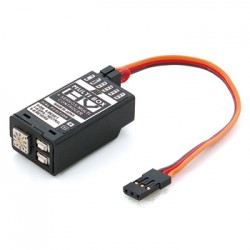Geen producten
Het product is succesvol aan uw winkelwagen toegevoegd
Er zijn 0 artikelen in uw winkelwagen. Er is 1 artikel in uw winkelwagen.
Meer informatie
JR Multi Box
De multi box is ontworpen als mren beperkt bent in het aantal kanalen en toch meerdere servo's wilt aansturen.
Met de multi box is het mogelijk de servo onderling af teregelen en indien nodig van een extra batterij te voorzien.
Afmeting ; 37 x 21 x 14 mm
Gewicht : 12 Gram
Input Voltage : 4,8 - 6 volt
Product Description
JR's Multi Box was developed to help match multiple servos when used to operate single control surfaces on large- scale model aeroplanes. Multiple servos not only provide redundancy, enabling the pilot to retain control in the rare event that a servo should fail in flight, but they can also be ganged up to provide extra torque. This is common practice, especially with very large jets and IMAC style scale aerobatic machines, where it is common to use between two and four servos on each control surface.
However, even with the best digital servos, some degree of mismatch can be expected due to the different geometry of each linkage. For instance, on a large scale Extra, with its tapered ailerons and, say, four control horns driven by four servos, you can appreciate that each linkage will have a different geometry. And it is very unlikely that you will be able to build the model with all the control horns located exactly over the hinge line. Servos will also have slightly different centring characteristics from unit to unit, even if they are of the same type.
So put four powerful digital servos on the same control surface and there is a real risk that they will effectively start fighting each other. Even the slightest mismatch could cause them to draw large amounts of current from the on-board batteries.
To minimise this we recommend the use of a JR Multi Box that allows you to operate up to four servos from a single receiver channel. Each servo can be adjusted independently using the same familiar functions that are available in JR transmitters:
- Sub Trim allows you to adjust the centring of each servo.
- Travel Adjust gives adjustment to the throw in each direction.
- Reversing allows the servo to change direction.
- Reset returns all the above to neutral.
Multi Box also can also be connected to a separate battery. This is especially useful when using powerful servos that draw a lot of current. Powering the servos from a different battery to the receiver will help minimise the chance of a 'brown out' which can happen when power to the receiver falls below its working threshold. Effectively the receiver can switch off for a short time and this is a real possibility if you are running the receiver and several high performance digital servos from a single battery pack (especially if the battery is old or of low quality).
A secondary benefit is the possibility of connecting a gyro between the receiver and the Multi Box, giving stabilisation to the attached servos.
The Multi Box can also be used for different types of servo. For instance you could run a high torque servo for your rudder and gang it to a standard servo to take care of nose-wheel steering. By using the independent adjustments on the Multibox, you can set the rudder to give a large control throw and have the nose-wheel turn proportionately less so it has tame ground handling - a real boon when flying from tarmac.. Sure, you could do this with mechanical geometry but it's so much easier with a Multi Box.



